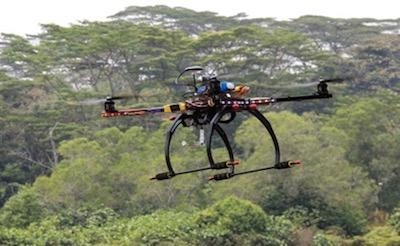Thu, Feb 22, 2018
Releases InFO Saying Drone Operators Should Be Easily Identified By The Public
In order to help bolster public awareness of sUAS operations and reduce the number of distractions for remote pilots and others participating in sUAS operations, the FAA recommends remote pilots in command, anyone operating the flight controls of the sUAS, visual observers, and any other person providing assistance in the sUAS operation wear brightly colored and reflective vests during flight operations.

In an Information For Operators (InFO) released by the agency, the FAA says the vest should have wording on the back identifying the individual as the remote pilot, visual observer, or other person involved in the sUAS operation. The vests should have wording such as “Drone Pilot Please Do Not Disturb”, “Drone Pilot Stand Clear”, “Drone Pilot”, “Designated Visual Observer” or similar for purposes of identification and to caution against distraction.
A vest as described above is easily distinguishable and often used by other safety-centric personnel such as construction and utility workers, airport ground crews, and railway personnel. The vest may reduce the likelihood someone will approach or query a person involved in sUAS operations.
While the use of highly visible reflective vests is intended to aid in the identification of sUAS remote pilots and others participating in sUAS operations and minimize the likelihood of distractions during such operation, their use does not negate the need to respond to requests from law enforcement in an urgent manner. Title 49 USC 44103(d) requires operators of aircraft (to include UAS) to make available for inspection a certificate of registration for the aircraft when requested by a United States Government, State, or local law enforcement officer. Operators must heed law enforcement requests for documentation and should abide by other requests from law enforcement officials.
The FAA recommends remote pilots and other persons participating in the sUAS operation wear brightly colored and reflective vests during such operation. The vest should have wording on the back identifying the individual as the remote pilot, visual observer, or other person participating in the sUAS operation and include a caution against distracting the person wearing such vest.
(Image from file)
More News
He Attempted To Restart The Engine Three Times. On The Third Restart Attempt, He Noticed That Flames Were Coming Out From The Right Wing Near The Fuel Cap Analysis: The pilot repor>[...]
Make Sure You NEVER Miss A New Story From Aero-News Network Do you ever feel like you never see posts from a certain person or page on Facebook or Instagram? Here’s how you c>[...]
From 2009 (YouTube Edition): Leading Air Show Performers Give Their Best Advice for Newcomers On December 6th through December 9th, the Paris Las Vegas Hotel hosted over 1,500 air >[...]
Aero Linx: NASA ASRS ASRS captures confidential reports, analyzes the resulting aviation safety data, and disseminates vital information to the aviation community. The ASRS is an i>[...]
“For our inaugural Pylon Racing Seminar in Roswell, we were thrilled to certify 60 pilots across our six closed-course pylon race classes. Not only did this year’s PRS >[...]
 NTSB Final Report: Rutan Long-EZ
NTSB Final Report: Rutan Long-EZ ANN FAQ: Turn On Post Notifications
ANN FAQ: Turn On Post Notifications Classic Aero-TV: ICAS Perspectives - Advice for New Air Show Performers
Classic Aero-TV: ICAS Perspectives - Advice for New Air Show Performers ANN's Daily Aero-Linx (06.28.25)
ANN's Daily Aero-Linx (06.28.25) Aero-News: Quote of the Day (06.28.25)
Aero-News: Quote of the Day (06.28.25)



